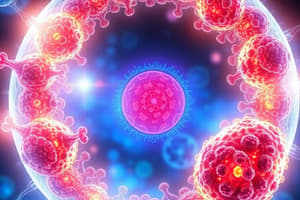Podcast
Questions and Answers
What is the primary purpose of the G1 phase in the cell cycle?
What is the primary purpose of the G1 phase in the cell cycle?
- To prepare for DNA replication and monitor external signals (correct)
- To divide the nucleus and cytoplasm into two daughter cells
- To ensure accurate DNA replication has occurred
- To perform apoptosis and eliminate damaged cells
Which checkpoint is critical for determining whether a cell proceeds to DNA replication?
Which checkpoint is critical for determining whether a cell proceeds to DNA replication?
- G2 checkpoint
- M checkpoint
- G1 restriction point (correct)
- Cytokinesis checkpoint
In which phase does the cell ensure all DNA has been accurately replicated before division?
In which phase does the cell ensure all DNA has been accurately replicated before division?
- M Phase
- S Phase
- G1 Phase
- G2 Phase (correct)
What happens during cytokinesis?
What happens during cytokinesis?
Which regulatory molecules are primarily involved in the checkpoint processes of the cell cycle?
Which regulatory molecules are primarily involved in the checkpoint processes of the cell cycle?
What triggers G1 senescence in a cell?
What triggers G1 senescence in a cell?
During which phase does DNA replication occur?
During which phase does DNA replication occur?
What is the consequence of a cell entering the G0 phase?
What is the consequence of a cell entering the G0 phase?
Which of the following correctly matches a phase with its activity?
Which of the following correctly matches a phase with its activity?
Which statement about checkpoints in the cell cycle is accurate?
Which statement about checkpoints in the cell cycle is accurate?
What is the primary function of hyperphosphorylated Rb in the cell cycle?
What is the primary function of hyperphosphorylated Rb in the cell cycle?
How does E2F-dependent transcription influence the cell cycle?
How does E2F-dependent transcription influence the cell cycle?
Which statement correctly contrasts cyclins and CDKs?
Which statement correctly contrasts cyclins and CDKs?
What happens as a result of increased activity of CDK2?
What happens as a result of increased activity of CDK2?
What is the role of cyclins in the cell cycle?
What is the role of cyclins in the cell cycle?
During which phase do cyclins specifically trigger the activity of CDK2?
During which phase do cyclins specifically trigger the activity of CDK2?
Which enzyme is directly responsible for the phosphorylation events that drive the cell cycle forward?
Which enzyme is directly responsible for the phosphorylation events that drive the cell cycle forward?
What is the consequence of blocking E2F-dependent transcription?
What is the consequence of blocking E2F-dependent transcription?
Which of the following statements about cyclins is false?
Which of the following statements about cyclins is false?
What triggers the upregulation of CDK2 during the cell cycle?
What triggers the upregulation of CDK2 during the cell cycle?
What is the initial step in E2F promoter repression during the cell cycle?
What is the initial step in E2F promoter repression during the cell cycle?
Which protein complex is primarily responsible for the phosphorylation of pRb?
Which protein complex is primarily responsible for the phosphorylation of pRb?
In which phase of the cell cycle is hypophosphorylated pRb predominantly found?
In which phase of the cell cycle is hypophosphorylated pRb predominantly found?
What is the consequence of pRb hyperphosphorylation during cell cycle progression?
What is the consequence of pRb hyperphosphorylation during cell cycle progression?
What defines the activity of transcription factor complexes in cell cycle regulation?
What defines the activity of transcription factor complexes in cell cycle regulation?
What is the role of E2F transcription factors in the cell cycle?
What is the role of E2F transcription factors in the cell cycle?
Which of the following is a characteristic of pRb in its hypophosphorylated state?
Which of the following is a characteristic of pRb in its hypophosphorylated state?
What mechanism leads to E2F activation during the cell cycle?
What mechanism leads to E2F activation during the cell cycle?
Which cyclin-CDK pair is primarily involved in the G1/S transition?
Which cyclin-CDK pair is primarily involved in the G1/S transition?
What is the primary role of the p53 molecule in the cell cycle?
What is the primary role of the p53 molecule in the cell cycle?
At which phase does Cyclin A + CDK1/2 have its maximum activity?
At which phase does Cyclin A + CDK1/2 have its maximum activity?
Which effect does the phosphorylation of Rb (Retinoblastoma protein) have on cell cycle regulation?
Which effect does the phosphorylation of Rb (Retinoblastoma protein) have on cell cycle regulation?
What primarily regulates the activity of CDKs?
What primarily regulates the activity of CDKs?
What is the function of p21 in the context of cell cycle regulation?
What is the function of p21 in the context of cell cycle regulation?
Which statement correctly describes CDK levels throughout the cell cycle?
Which statement correctly describes CDK levels throughout the cell cycle?
How do cyclins contribute to cell cycle progression?
How do cyclins contribute to cell cycle progression?
Which cyclin-CDK pair is involved in the increase of activities during the G1 phase?
Which cyclin-CDK pair is involved in the increase of activities during the G1 phase?
What role does the E2F transcription factor play in cell cycle regulation?
What role does the E2F transcription factor play in cell cycle regulation?
When are cyclins typically degraded?
When are cyclins typically degraded?
Which cyclin peaks during G2 and M phases?
Which cyclin peaks during G2 and M phases?
How is the expression of cyclins characterized throughout the cell cycle?
How is the expression of cyclins characterized throughout the cell cycle?
What is the relationship between cyclins and CDKs in terms of action?
What is the relationship between cyclins and CDKs in terms of action?
Which factor is responsible for the timing of cyclin availability during the cell cycle?
Which factor is responsible for the timing of cyclin availability during the cell cycle?
Flashcards are hidden until you start studying
Study Notes
E2F Promoter Activation and Repression
- Repression Mechanism: In G1 phase, hypophosphorylated pRb binds to E2F transcription factors, preventing gene activation necessary for S phase.
- Additional Repressors: Proteins p107 and p130 further inhibit E2F activity.
- Activation Process: Cyclin/CDK complexes phosphorylate pRb, allowing release of E2F transcription factors.
- E2F Function: Once released, E2F binds to promoters, stimulating transcription of genes for DNA replication.
pRb Phosphorylation States
- Hypophosphorylated pRb:
- Binds tightly to E2F, repressing its activity; associated with early G1 phase.
- Hyperphosphorylated pRb:
- Released E2F enables activation of genes for DNA replication; occurs during late G1 and S phase.
Role of Transcription Factor Complexes in Cell Cycle Regulation
- Overview: Transcription factor complexes regulate gene expression critical for cell cycle progression.
- Key Players: E2F transcription factors are vital for activating genes required for DNA synthesis and S phase entry.
Cell Cycle Stages and Steps
- G1 Phase:
- Cell growth, preparation for DNA replication, normal functions, external signal monitoring.
- S Phase:
- DNA replication occurs, ensuring that chromosomes are duplicated accurately.
- G2 Phase:
- Continued cell growth, ensuring complete and correct DNA replication, final preparations for mitosis.
- M Phase (Mitosis):
- Division of the nucleus and cytoplasm into two daughter cells; includes prophase, metaphase, anaphase, and telophase.
- Cytokinesis:
- Final cytoplasmic division resulting in two separate daughter cells.
- Checkpoints:
- Regulate cell growth, DNA integrity, and division to maintain genomic stability.
G0 Phase
- Description: Exit from the cell cycle; cells remain metabolically active but do not divide.
- Characteristics: Cells can become senescent and require changes to return to active division.
- Triggers for Senescence: G1 senescence due to chromosome changes or DNA damage; G2 only from DNA damage.
Activities During Cell Cycle Stages
- G1 Activities:
- Growth, protein and organelle synthesis, preparation for DNA synthesis.
- S Phase Activities:
- DNA replication and chromosome duplication; controlled by E2F activity and CDK regulation.
Cyclins and Cyclin-Dependent Kinases (CDKs)
- Cyclins:
- Regulatory proteins synthesized and degraded at specific cell cycle points, determining CDK activation.
- CDKs:
- Enzymes phosphorylating target proteins to drive cell cycle progression; require cyclin binding for activity.
Cyclin-CDK Pairs and Cell Cycle Stages
- Cyclin D + CDK4, CDK6: Active in G1 phase.
- Cyclin E + CDK2: Peaks at G1/S transition.
- Cyclin A + CDK1/2: Active during S phase and early G2 phase.
- Cyclin B + CDK1: Peaks in G2 and M phase.
Key Molecules in Cell Cycle Regulation
- p53: Induces cell cycle arrest or apoptosis in response to DNA damage; activates p21.
- pRb: Inhibits E2F to prevent transition to S phase; releases E2F upon phosphorylation.
- p21: Inhibits cyclin/CDK complexes, halting cell cycle progression for DNA repair.
- E2F: Transcription factor promoting S phase genes; regulated by pRb.
- Cyclins: Activate CDKs to regulate the cell cycle phases; specific cyclins serve distinct phases.
Consequences of Changes in Regulation
- E2F Binding: Impacted by pRb phosphorylation status, affecting DNA replication.
- Cyclin/CDK Activity: Changes can lead to premature or delayed cell cycle progression.
- Fatty Acid Metabolism: Influenced by cell cycle regulatory processes.
- Transcription Factor Complexes: DREAM complex binding can suppress transcription, influencing cell cycle control.
Studying That Suits You
Use AI to generate personalized quizzes and flashcards to suit your learning preferences.




